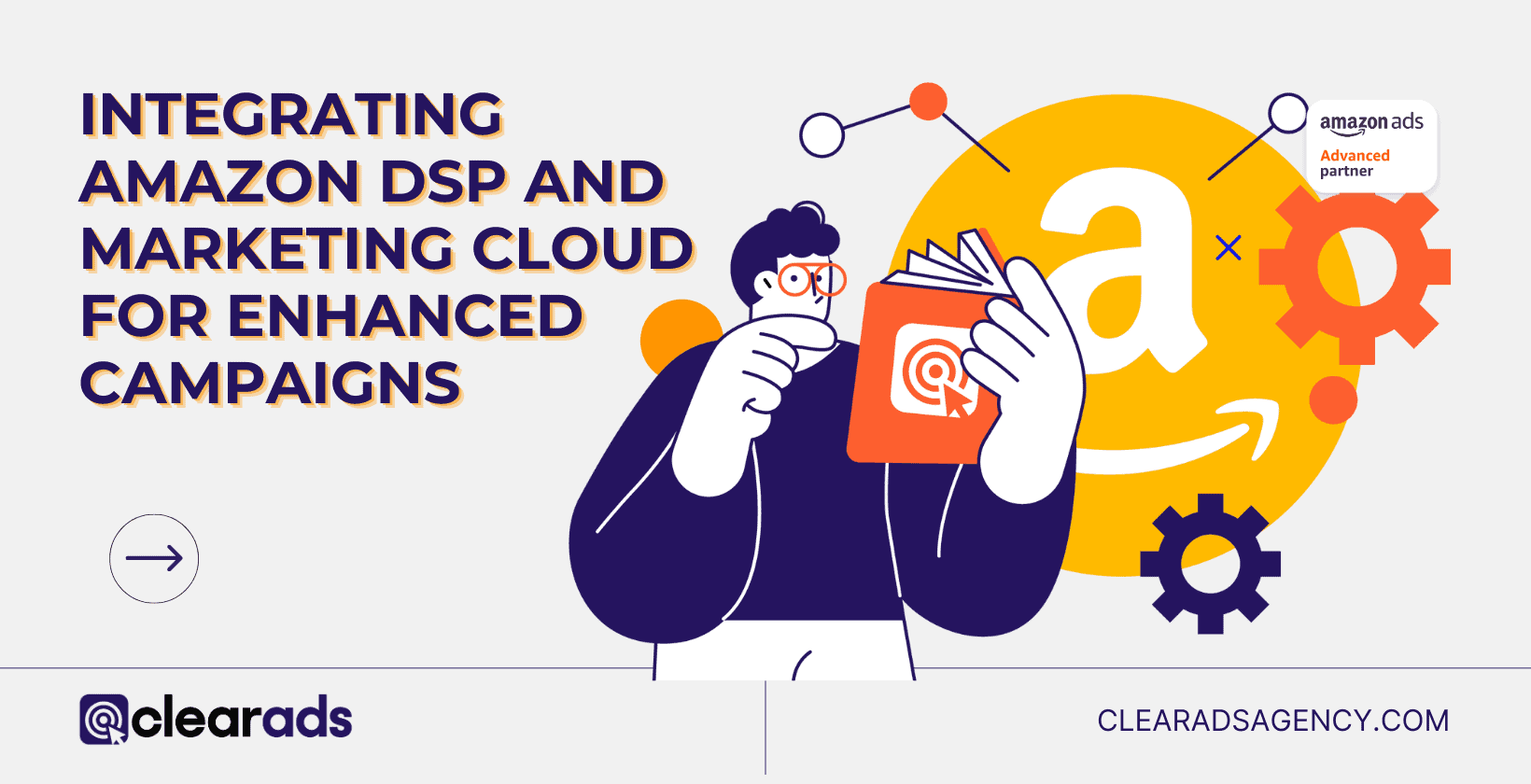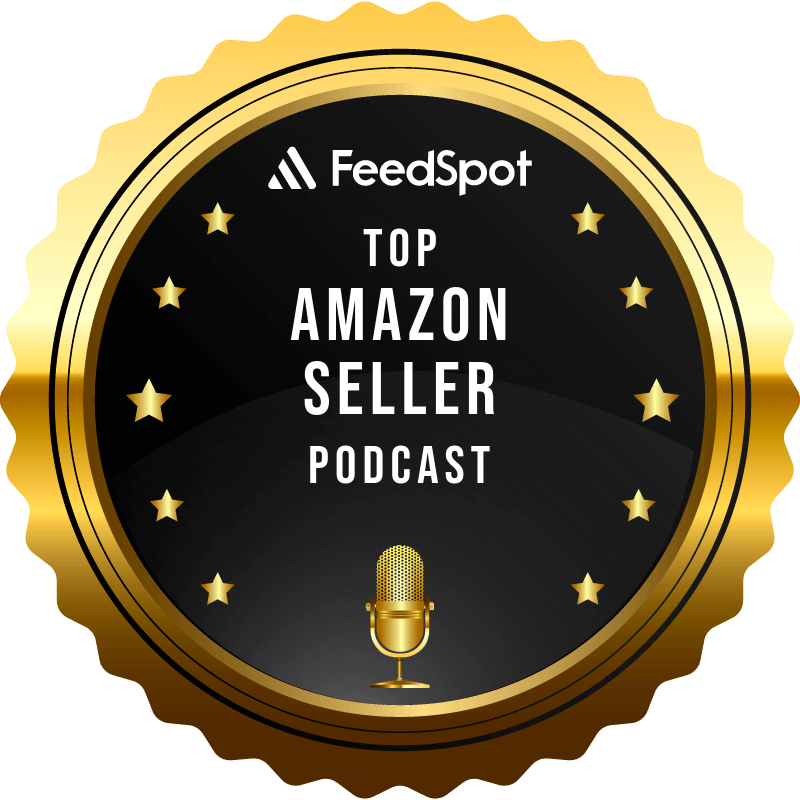Mastering Performance Measurement and Analytics in Amazon DSP
- Post Published:
Mastering Performance Measurement and Analytics in Amazon DSP revolves around harnessing the full capabilities of Amazon’s Demand Side Platform to optimize digital advertising campaigns. It involves understanding and utilizing various metrics and analytical tools to assess and enhance campaign performance. Key aspects include tracking vital metrics like click-through rates and conversion rates, effectively using DSP analytics reports for strategic decision-making, and adapting strategies based on audience insights and engagement metrics. This topic is crucial for advertisers seeking to maximize their ROI and make data-driven decisions in the dynamic and competitive space of digital advertising.
In today’s fast-paced digital advertising world, mastering Amazon DSP (Demand Side Platform) is crucial for marketers and advertisers looking to make an impact. This essential guide delves into the art and science of performance measurement and analytics within Amazon’s powerful advertising platform. It’s designed to equip you with the knowledge and tools needed to navigate, analyze, and optimize your campaigns effectively. From understanding key performance metrics to implementing data-driven strategies, this guide serves as an invaluable resource for enhancing your Amazon DSP campaigns and maximizing return on investment. Whether you’re a seasoned marketer or new to Amazon DSP, this document offers insights and practical tips to elevate your digital advertising game.
When using Amazon DSP, it’s important to track key performance metrics to evaluate the effectiveness of your advertising campaigns. KPI (Key Performance Indicator) benchmarking in Amazon DSP is a strategic process that involves setting clear and objective metrics to measure the success of your advertising campaigns. Amazon DSP (Demand Side Platform) reports offer actionable, data-driven findings that create tangible business value. Audience insights enable brands and advertisers to better understand their customers’ interests and behaviors to improve discoverability and engagement throughout the sales funnel. Amazon provides a range of advanced tools to utilize when running DSP campaigns on the platform including but not limited to Amazon Marketing Cloud, Brand Metrics, and Cross-Device Reporting. Predictive analytics is revolutionizing the landscape of digital advertising, particularly within Amazon’s Demand Side Platforms. Amazon DSP is heading towards more advanced, integrated, and user-focused technologies.
What Key Metrics Should You Track in Amazon DSP?
When using Amazon DSP, it’s important to track key performance metrics to evaluate the effectiveness of your advertising campaigns.
The 7 key metrics to track include:
- Impressions: The total number of times your ad was displayed.
- Click-Through Rate (CTR): The percentage of impressions that resulted in a click, indicating how compelling your ad is to your target audience.
- Cost-per-click (CPC): The average cost you pay for each click on your ad, which helps in understanding the cost-effectiveness of your campaign.
- Conversion Rate: The percentage of clicks that result in a desired action, such as a purchase or sign-up, showing how effectively your ad drives results.
- Return on Ad Spend (ROAS): The total revenue generated from the ad campaign is divided by the total ad spend, measuring the overall return on investment.
- Advertising Cost of Sales (ACoS): The ratio of ad spend to targeted sales, is useful for understanding the efficiency of your ad spend in driving sales.
- Total Advertising Cost of Sales (TACoS): A broader measure that includes the impact of advertising on overall sales, not just those directly attributed to the DSP campaign.
Tracking these metrics helps you optimize your ad spend, improve campaign performance, and achieve better ROI on Amazon DSP.
17 Other metrics available to track in Amazon DSP:
- Sales
- Purchases
- Repeat purchase behavior
- D P/V
- Inventory
- Invoice Defect Rate
- ATC
- Average order value
- Clicks
- Costs
- Customer lifetime value
- ERPM
- Product ranking
- Product reviews
- Similar product views
- The customer journey
- Units sold
How Can You Effectively Utilize Amazon DSP’s Analytics Reports?

Effectively harnessing the analytical power of Amazon’s Demand-Side Platform (DSP) is key to elevating the success of your advertising campaigns. At the heart of this process is a strategic use of the platform’s extensive data and analytical capabilities. This entails a deep dive into consumer behavior and ad performance, refining targeting strategies, and keeping a close eye on pivotal metrics like impressions, clicks, and conversions. By tapping into these rich insights, advertisers can fine-tune their campaigns, leading to improved performance and an increased return on investment.
Before delving into Amazon DSP’s analytics, it’s crucial to have a clear understanding of your campaign goals. This clarity guides the analytical process and ensures that the data you focus on is aligned with your objectives.
Steps to Leverage Amazon DSP Analytics Effectively:
Master Key Metrics: Develop a solid understanding of essential metrics such as impressions, click-through rates, conversion rates, and Return on Ad Spend (ROAS). These metrics are the building blocks for assessing the health and effectiveness of your campaigns.
Customize Reports for Targeted Insights: Adapt your reports to zero in on the data that matters most to your campaign’s unique goals. This customization enables a more focused analysis and strategic planning.
Harness Audience Insights: Dive into audience data to get a clear picture of who is interacting with your ads and their response patterns. This information is invaluable for sharpening your targeting strategies.
Evaluate Performance Trends: Utilize historical data to spot trends and patterns that can inform the trajectory of your campaign strategies. Keeping an eye on the long-term performance helps in making informed adjustments.
Pursue Data-Driven Optimization: Make it a regular practice to review and analyze report data for making informed campaign adjustments. The insights drawn from these reports are instrumental in fine-tuning your approach for enhanced campaign performance.
Engage in Comparative Analysis: Put different ad creatives, formats, and targeting strategies head-to-head to see which elements resonate most effectively with your audience. This comparative analysis is key to understanding what drives success in your campaigns.
By strategically leveraging the analytical capabilities of Amazon DSP, advertisers are empowered to make informed, data-driven decisions. This approach not only amplifies the effectiveness of your campaigns but also drives a more efficient allocation of your advertising spend, ultimately boosting your ROI.
How to access analytics reports:
- Log into the Amazon Ads console.
- Click “Measurement & Reporting” in the menu.
- Select “Amazon DSP Reports”.
- Click “New Custom Report”.
- Choose the report type and time unit.
- Select desired columns.
- Pick the report period and enter the report name.
- Choose delivery type and enter email if needed.
- Set the report request time.
- Click “Run”.
- Click on the report name and then download it.
9 Types of Amazon DSP reports:
- Campaign Report
- Inventory Report
- Geography Report
- Audience Report
- Technology Report
- Products Report
- Conversion Source Report
- Off-Amazon Report
- Industry Standard Report
Interpreting Data: Understanding DSP Campaign Performance
Analyzing changes in key metrics from Amazon DSP reports can provide valuable insights into your campaign’s performance.
Here’s what changes in metrics might indicate and how to respond to them:
Impressions:
Increase: Indicates broader reach. If not accompanied by a proportional increase in clicks or conversions, it might suggest that the ad isn’t resonating with the audience.
Decrease: This could be due to reduced ad spend, higher competition, or less effective targeting.
Action: Review targeting settings and ad spend. If impressions are high but clicks are low, consider updating the creative or the offer to be more appealing.
Click-Through Rate (CTR):
Increase: Suggest that your ad creative or message is compelling and relevant to the audience.
Decrease: Indicates that the ad might not be appealing or relevant to the viewers.
Action: For low CTR, revise your ad copy or creative elements. Test different variations to see what resonates with your audience.
Cost-per-Click (CPC):
Increase: This could indicate increased competition for ad space or less effective ad targeting.
Decrease: Suggests you’re getting more clicks for your budget, which is generally positive.
Action: For high CPC, explore less competitive keywords or audience segments. Improve ad quality and relevance to potentially lower CPC.
Conversion Rate:
Increase: This shows that a higher percentage of users who click on your ad are completing the desired action, indicating effective ad targeting and compelling landing pages.
Decrease: This may suggest that the landing page isn’t meeting user expectations, or the ad isn’t attracting the right audience.
Action: Optimize landing pages for conversions. Ensure consistency between ad content and landing page.
Return on Ad Spend (ROAS):
Increase: Indicates that your ads are generating more revenue relative to the ad spend.
Decrease: Your ads are not generating expected revenue, which could be due to several factors, including targeting, ad content, or market changes.
Action: Reassess your campaign strategy. Focus on high-performing products or audiences and adjust pricing or offers if necessary.
Advertising Cost of Sales (ACoS):
Increase: You’re spending more on ads relative to the revenue generated.
Decrease: More efficient use of your advertising budget.
Action: For high ACoS, improve targeting efficiency, or revise your bidding strategy.
Total Advertising Cost of Sales (TACoS):
Increase: Indicates higher advertising spend relative to total sales, not just the sales directly attributed to DSP campaigns.
Decrease: Suggests more effective overall advertising spending.
Action: Analyze the impact of DSP campaigns on overall sales and adjust ad spend accordingly.
Monitoring these metrics will provide an understanding of the performance of Amazon DSP campaigns. Regularly analyzing and responding to changes in these metrics is the most effective method of optimizing campaigns to improve performance. The key to seeing better-performing ad campaigns is to test, learn, and iterate based on data-driven insights.
How to Set Realistic KPIs for Benchmarking Success in DSP Campaigns?
KPI (Key Performance Indicator) benchmarking in Amazon DSP is a strategic process that involves setting clear and objective metrics to measure the success of your advertising campaigns. Setting realistic KPIs for benchmarking success revolves around identifying key factors such as efficiency, quality, timeliness, and performance. This process provides a structured approach to track and measure performance over time, ensuring alignment with the business’s campaign goals.
KPIs offer objective and clear information on the progress toward achieving specific campaign goals. They aid in tracking and measuring crucial factors like campaign efficiency, ad quality, timeliness of execution, and overall performance. KPIs also provide a consistent way to assess performance across different periods, allowing for strategic adjustments based on long-term data.
Key KPIs in Amazon DSP and Benchmarking Them:
- Conversion Rate: Benchmark against industry averages (e.g., 2%) to evaluate performance in converting visitors to customers.
- Click-Through Rate (CTR): Assess performance against industry standards (e.g., 0.5% for display ads) and identify improvement opportunities.
- Cost per Acquisition (CPA): Compare against industry averages (e.g., $50) to evaluate efficiency in customer acquisition while maintaining quality.
- Return on Ad Spend (ROAS): Set targets based on industry benchmarks (e.g., 5:1 ratio) to measure revenue generated per advertising dollar spent.
- Website Traffic: Benchmark your website traffic against industry standards to assess online visibility and audience reach.
Setting Realistic Benchmarks and Managing KPIs:
- Defining Success: Once your campaign goals are set, it’s crucial to define what success looks like and set smaller, achievable benchmarks.
- Avoiding Information Overload: Be cautious of setting too many KPIs, as it can lead to difficulty in focusing on what’s most important.
- Clear and Unambiguous Targets: Vague or ambiguous KPIs can make it challenging to assess performance accurately.
- Team Involvement and Understanding: Ensure that your team understands, is involved in, and buys into the purpose and benefits of KPIs. Fostering a culture of accountability and ownership is essential.
- Measuring Intangibles: Defining KPIs for intangible aspects like customer satisfaction or brand perception can be challenging. These often require subjective assessments or indirect indicators.
KPI Benchmarking Process:
- Determine Crucial KPIs: Identify KPIs that are critical for measuring performance in your specific business area.
- Define Benchmarks: Identify industry standards or top performers for each KPI.
- Gather Data: Collect data for your KPIs and established benchmarks, including internal data, external research, or industry reports.
- Analyze and Compare: Investigate performance gaps, strengths, and weaknesses by comparing your KPIs against benchmarks.
• Set Improvement Targets: Based on the analysis, set realistic targets considering best practices observed in the benchmarking process. - Implement Improvement Strategies: Adopt initiatives such as process optimization, new technologies, employee training, etc., to enhance performance.
- Monitor and Evaluate Progress: Continuously compare KPI progress against benchmarks to evaluate the effectiveness of your strategies and make necessary adjustments.
By effectively implementing KPI benchmarking in Amazon DSP, sellers will gain a deeper understanding of their campaign performance, identify areas for improvement, and strategically enhance their advertising efforts for better ROI.
Why Is Conversion Tracking Crucial in Amazon DSP and How to Implement It?
When it comes to enhancing conversion rates in advertising, several factors play a pivotal role. First, having clear, concise messaging with a strong call to action is essential. This clarity helps guide potential customers through the buying process. Second, it’s important to consider the number of ad impressions, along with volume and frequency caps, to avoid overwhelming your audience. Third, employing conversion-focused media tactics, such as retargeting and search engine marketing, can significantly bolster your campaign’s effectiveness.
Understanding total conversion metrics is crucial in advertising. These metrics don’t just reflect sales of the advertised product (ASIN) but encompass all sales generated within the brand during the campaign. This broader view captures the full value delivered by your brand’s advertising efforts.
Amazon DSP metrics provide insights into the performance of advertised products and offer a summary of the brand’s overall sales. Each display campaign contributes not only to the awareness of the advertised product but also elevates the brand and its entire store. Therefore, monitoring which products see an increase in sales during a campaign is key.
However, campaign performance might not be immediately apparent in the total sales figures. A lower Return on Ad Spend (ROAS) in one area doesn’t necessarily mean that the total ROAS is low. By focusing on assisted sales, you can identify other products with greater potential for improved sales.
Advertising products that align more closely with user interests can lead to even better results. These insights are invaluable for fine-tuning audience targeting, understanding customer needs, and gauging purchase intent.
The Amazon Marketing Cloud significantly impacts the understanding and optimization of the DSP Path to Conversion by Device in several ways:
- Unified Data Analysis: AMC offers a more comprehensive view of the customer journey by integrating data from various sources, crucial for understanding the role of different devices in the conversion process.
- Advanced Attribution Modeling: AMC enables advertisers to use sophisticated attribution models that account for the multifaceted nature of modern consumer journeys across multiple devices.
- Cross-Device Tracking and Insights: AMC aids in effectively tracking and analyzing customer interactions across multiple devices, essential for spotting trends in device usage throughout the customer journey.
- Improved Targeting and Personalization: With AMC data, advertisers can more effectively tailor their Amazon DSP campaigns for different devices, ensuring the delivery of the right message at the right time.
- Enhanced Reporting and Visualization: AMC’s advanced reporting capabilities help visualize the conversion path across devices, aiding in understanding complex behaviors and the influence of various devices.
- Optimization of Ad Spend: Insights from AMC allow advertisers to allocate their ad budget more efficiently, focusing on the devices and touchpoints most likely to result in conversions.
- Real-Time Decision Making: The real-time data processing of AMC enables advertisers to make quick adjustments to their campaigns for device-specific performance as customer interactions unfold.
What Insights Can You Gain from Amazon DSP Reports for Strategic Decision-Making?
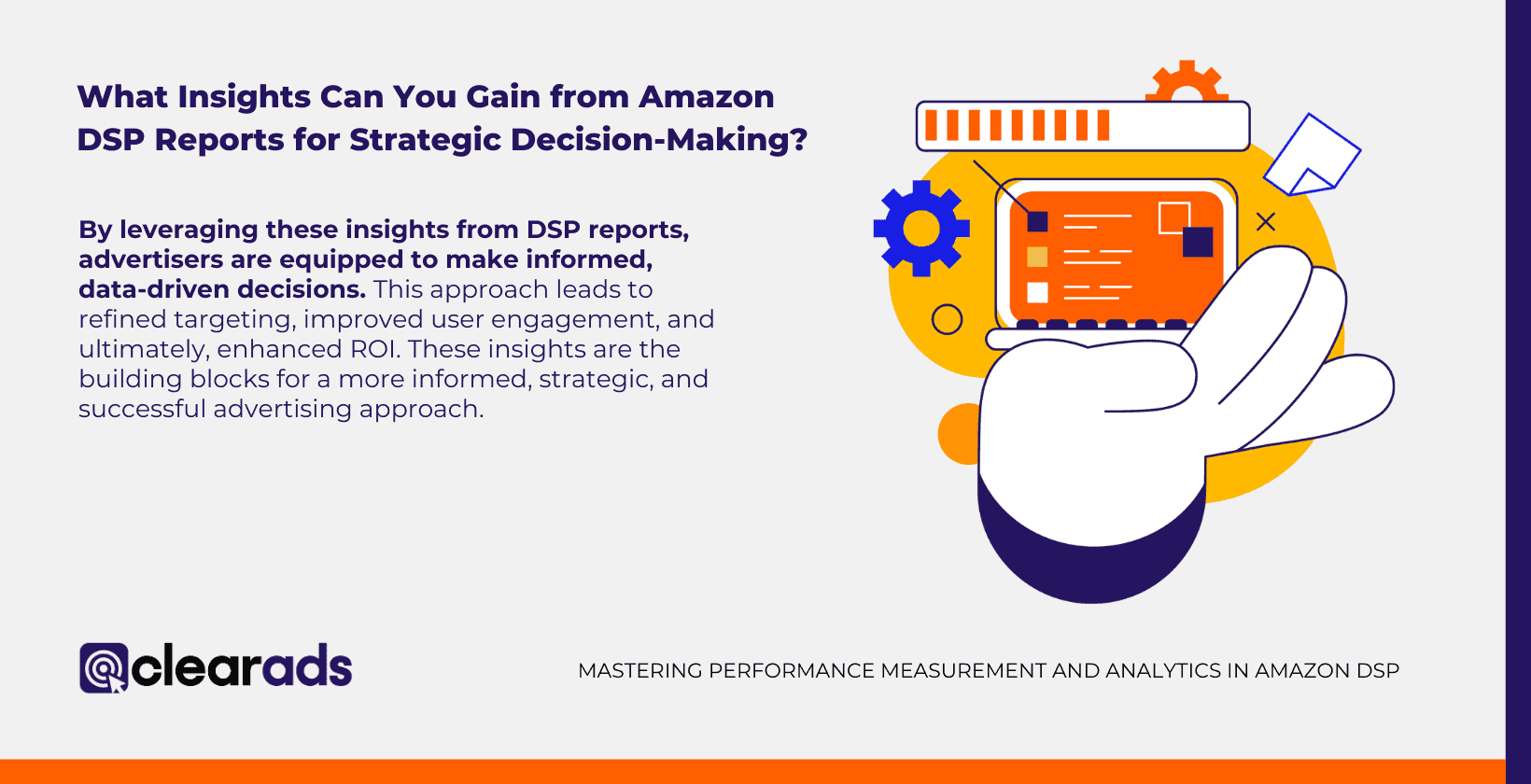
Amazon DSP (Demand Side Platform) reports offer actionable, data-driven findings that create tangible business value.
The key insights available from DSP ad reports and how they inform advertising strategies:
Audience Insights
- Behavior and Preferences: Gain a deep understanding of your audience’s online behavior, preferences, and interests. This knowledge is vital for tailoring your ads to resonate with your target market.
- Demographic Data: Access detailed insights into crucial demographic information such as age, gender, and location of your audience, enabling more precise targeting.
- Segment Performance: Analyze how different audience segments are interacting with your ads. This insight allows for the customization of campaigns to specific audience needs and behaviors.
Campaign Performance
- Ad Effectiveness: Evaluate your ads based on engagement metrics, click-through rates, and conversions to identify top performers.
- Creative Analysis: Understand which creative elements, including images, copy, and calls-to-action, are driving your campaign’s success.
- Optimal Ad Placements: Identify the most effective placements and ad formats, guiding where to focus your advertising efforts.
Conversion Tracking
- Conversion Rates: Measure the effectiveness of your ads in driving the desired actions, such as purchases or sign-ups.
- Path to Conversion: Unpack the customer journey to see how various touchpoints contribute to conversions.
- Post-Click Behavior: Gain insights into user activities post-ad click, such as how they interact with your website, providing clues to optimize the user experience.
Return on Investment (ROI)
- Return on Ad Spend (ROAS): Calculate the revenue generated for every advertising dollar spent, a key metric for evaluating campaign profitability.
- Cost-Effectiveness: Assess the cost-effectiveness of your campaigns in terms of cost per click, impression, and acquisition, ensuring efficient use of your advertising budget.
Website Traffic Analysis
- Traffic Sources: Understand the sources of your web traffic and their correlation with your DSP campaigns.
- User Engagement: Dive into post-click user interaction data, including bounce rates and session duration, to enhance website engagement strategies.
Inventory Insights
- Site Performance: Identify which websites or types of inventory are most effective for your ads.
- Supply Sources: Understand the performance of various supply sources, such as Amazon-owned sites versus third-party exchanges, to optimize ad placements.
Technology and Device Usage
- Device Preferences: Determine which devices your audience predominantly uses and tailor your campaigns for optimal visibility and engagement on these platforms.
- Browser and OS Insights: Acquire knowledge about the most common browsers and operating systems used by your audience, informing technical aspects of ad delivery.
Geographic Insights
- Regional Performance: Analyze ad performance across different geographic regions to inform and refine geo-targeting strategies.
- Market Differences: Understand how audience behavior and response to ads vary across different markets or regions, enabling localized campaign adjustments.
By leveraging these insights from DSP reports, advertisers are equipped to make informed, data-driven decisions. This approach leads to refined targeting, improved user engagement, and ultimately, enhanced ROI. These insights are the building blocks for a more informed, strategic, and successful advertising approach.
How to Understand Audience Insights and Engagement Metrics in DSP?
Audience insights enable brands and advertisers to better understand their customers’ interests and behaviors to improve discoverability and engagement throughout the sales funnel.
Audience Insights Available
- Demographic Data: Use this data to tailor your messaging and creatives to better suit the demographic characteristics of your audience.
- Interests and Behaviors: This information will create more relevant and compelling content that aligns with their preferences.
- Segmentation and Targeting: Tailor your campaigns to these segments for more personalized and effective targeting.
- Audience Overlap and Expansion: Use this to expand your targeting or to find new audience segments that might be interested in your products or services.
Analyzing Engagement Metrics
Click-Through Rate (CTR):
- A high CTR indicates that your ads are relevant and appealing to your audience.
- A low CTR might suggest the need to revise your ad creative or targeting strategy.
Conversion Rate:
- A low conversion rate might indicate a disconnect between the ad and the landing page or that the audience isn’t fully aligned with the offer.
Viewability and Impressions:
- High viewability and impressions count indicate good reach but should be evaluated alongside CTR and conversion rates for effectiveness.
Analyze which platforms, placements, or times result in higher viewability and impressions.
Engagement Time:
- Longer engagement times can indicate more compelling content or higher interest levels.
Optimizing your advertising campaigns requires a keen understanding of your audience and the ability to adapt quickly based on data-driven insights. Utilizing insights for campaign optimization involves several key steps that can significantly enhance the impact and efficiency of your DSP (Demand Side Platform) campaigns. Here’s a closer look at how to leverage these insights effectively:
Refining Campaign Targeting with Audience Insights
- In-Depth Audience Analysis: Dive deep into audience insights to understand the nuances of your target audience’s preferences and behaviors.
- Refined Targeting: Use these insights to fine-tune your campaign targeting settings, ensuring that your ads reach the most relevant and responsive users.
Creative Optimization: Crafting Resonant Advertisements
- Tailored Creatives: Develop ad creatives that align with the identified interests and behaviors of your audience. This could involve varying the messaging, imagery, and overall tone to better connect with different segments.
- A/B Testing: Implement A/B testing for different creative elements. This approach allows you to compare varying designs, messages, and formats to identify which combinations are most effective with each audience segment.
Strategic Budget Allocation: Maximizing Campaign Performance
- Focus on High-Performers: Allocate a larger portion of your budget to segments and ad placements that show the highest performance. This strategy ensures that your spending is targeted towards areas with the highest return.
- Dynamic Budget Adjustment: Be flexible in adjusting your budget allocation based on ongoing campaign performance and emerging trends in audience behavior.
The Cycle of Continuous Learning and Adjustment
- Regular Data Review: Consistently monitor audience insights and engagement metrics to stay informed about the performance of your campaigns.
- Agility in Strategy: Maintain a dynamic approach, ready to modify your campaign strategy in response to new data, market trends, and changing audience dynamics.
By meticulously analyzing audience insights and engagement metrics and embracing a culture of continuous iteration and refinement, you position your DSP campaigns for greater success. This data-centric approach ensures that your advertising efforts are not only aligned with your audience’s preferences but also adaptable to the ever-changing digital landscape. The result is a more effective campaign that resonates with your target audience, leading to improved performance and an enhanced return on investment.
What Are the Best Ways to Optimize Campaigns Based on DSP Analytics?
Optimizing campaigns based on DSP (Demand Side Platform) analytics involves a strategic approach to analyze data, identify areas for improvement, and make informed decisions to enhance campaign performance.
Here are some of the best ways to achieve this:
Analyze Performance Data Thoroughly:
Regularly review key metrics such as click-through rates (CTR), conversion rates, cost per acquisition (CPA), and return on ad spend (ROAS). This will identify trends and patterns that indicate campaign strengths and weaknesses.
Segmentation and Targeted Optimization:
Segment your audience based on demographics, interests, behaviors, and purchasing history. Doing this will tailor campaigns to each segment, optimizing for the unique characteristics and preferences of each group.
Creative Testing and Optimization:
Use A/B testing to compare different ad creatives and formats. Once an advertiser has this information, use it to analyze which creatives are most effective. Continuously refine this ad copy, visuals, and calls-to-action based on performance data for optimal results.
Bid Optimization and Budget Allocation:
Adjust the bidding strategy based on campaign performance, expenses will fluctuate throughout the year so it cannot be left alone. Consider using automated bidding strategies where applicable to optimize bids in real-time to conserve valuable time for the business.
Leverage Machine Learning and AI:
DSP has good machine learning capabilities to predict user behavior and optimize campaigns accordingly. Use these AI-driven insights for dynamic ad placements and real-time bidding adjustments.
Optimize for Cross-Device Engagement:
Understand how an audience interacts with ads across different devices. This will ensure all campaigns are optimized for mobile, desktop, and tablet, offering a seamless experience across all platforms.
Utilize Retargeting and Lookalike Audiences:
Implement retargeting strategies to re-engage users who have shown interest in your products or services.
Geographic and Time-based Optimization:
Optimize ad delivery times based on when your audience is most active and engaged.
Monitor and Adapt to Market Changes:
Be flexible and ready to adapt your strategy in response to external changes. As well as that, establish a feedback loop where insights from analytics are continuously used to refine campaign strategies.
The key is to stay data-driven, regularly review analytics, and be agile in your approach, adapting to both the data and the ever-changing digital advertising landscape.
How to Evaluate Ad Spend Efficiency in Your Amazon DSP Campaigns?
An effective Amazon DSP strategy ensures every dollar contributes significantly to the business’s marketing objectives.
How to evaluate and enhance ad spend efficiency in DSP campaigns on Amazon:
Understanding Return on Ad Spend (ROAS)
A high ROAS indicates that your campaign is generating a significant return relative to the amount invested. Benchmarking this against industry standards offers valuable insights into your campaign’s financial efficiency.
The Role of Cost Per Acquisition (CPA)
CPA measures the average cost of acquiring a new customer through your campaigns. A lower CPA is desirable, especially when considered in the context of the customer’s lifetime value.
The balance between cost and long-term customer value is a key indicator of your campaign’s economic impact.
Evaluating Click-Through Rates (CTR)
An increasing CTR suggests that your content resonates well with your audience, potentially leading to better ad spend efficiency.
Conversion Rate
The conversion rate is a direct measure of your campaign’s success. A higher conversion rate typically signals that an ad is translating effectively into tangible results.
Assessing Advertising Cost of Sales (ACoS) and TACoS
These metrics indicate the broader influence of ad spend on business performance.
Campaign-Specific KPIs
Identifying and monitoring campaign-specific KPIs allows for a tailored approach to measuring success.
Competitive Benchmarking
Benchmarking current campaigns against past performances sets realistic and ambitious goals for future campaigns, ensuring continuous improvement. Benchmarking a campaign’s current efficiency with industry and competitor standards also offers a broader perspective on performance.
Embracing Ongoing Optimization
The digital advertising arena is dynamic, necessitating continuous testing and optimization. Regular adjustments based on performance analytics ensure that your campaigns remain efficient and effective.
In conclusion, effectively managing ad spend in Amazon DSP campaigns requires a meticulous approach, blending analytics with strategic planning. By understanding and leveraging these key metrics and methods, advertisers can ensure their campaigns are not just reaching the audience but also delivering optimal returns on investment. This data-driven approach is fundamental to thriving in the competitive digital advertising space.
Which Advanced Analytical Tools Should You Use within Amazon DSP?
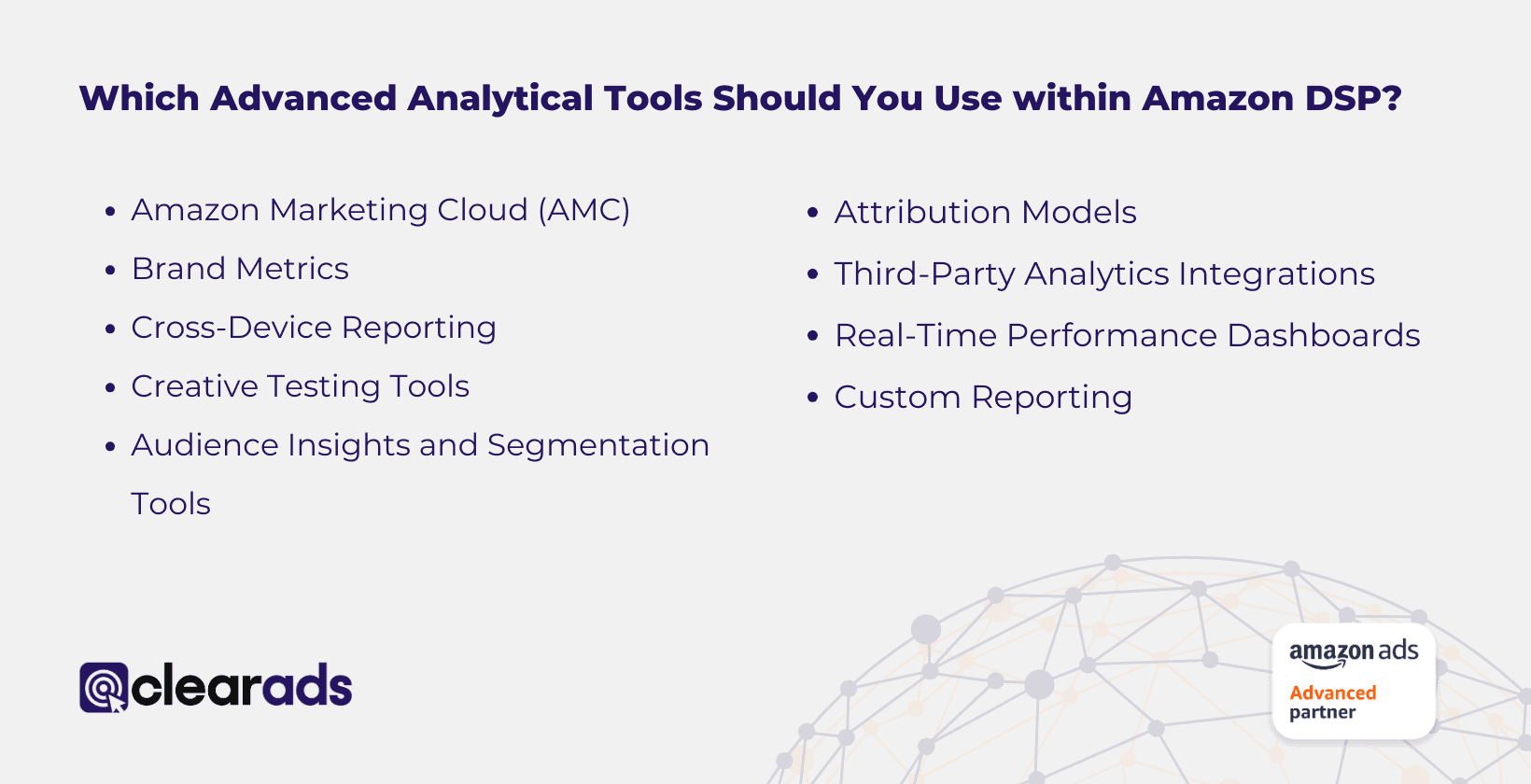
Amazon provides a range of advanced tools to utilize when running DSP campaigns on the platform including but not limited to Amazon Marketing Cloud, Brand Metrics, and Cross-Device Reporting. Utilizing advanced analytical tools within Amazon DSP (Demand Side Platform) is essential for deepening your understanding of campaign performance and enhancing decision-making. While Amazon DSP provides a robust set of built-in analytics, leveraging additional tools can offer more granular insights.
Here are 9 advanced analytical tools and features to use within Amazon DSP:
- Amazon Marketing Cloud (AMC): AMC is a powerful data analysis tool that provides more detailed insights into advertising campaigns across Amazon’s properties. It allows for the integration and analysis of various data sources, enabling advertisers to build customized reports and dashboards.
- Brand Metrics: This tool is designed to measure the impact of advertising on brand perception. Providing insights into brand awareness, consideration, and purchase intent, which are crucial for long-term brand-building strategies.
- Cross-Device Reporting: Amazon DSP’s cross-device reporting enables you to track and analyze how users interact with your ads across different devices. This feature is critical for understanding the multi-device behavior of consumers and optimizing campaigns accordingly.
- Creative Testing Tools: Use Amazon DSP’s creative testing tools to conduct A/B testing on different ad creatives, formats, and messaging. These tools will determine which creative elements are most effective at engaging your target audience.
- Audience Insights and Segmentation Tools: These tools offer deep insights into audience behavior, preferences, and demographics. They are essential for creating highly targeted campaigns and for personalizing ad content.
- Attribution Models: Utilize Amazon DSP’s advanced attribution models to understand the customer journey and to measure the impact of various touchpoints on conversions. These models help in allocating credit to different campaign aspects more accurately.
- Third-Party Analytics Integrations: Integrating with third-party analytics platforms can provide additional layers of data analysis. These integrations can offer specialized functionalities like heat mapping, advanced user behavior tracking, and more in-depth conversion tracking.
- Real-Time Performance Dashboards: Utilize real-time dashboards within Amazon DSP to monitor campaign performance live. These dashboards allow for quick decision-making and immediate optimizations.
- Custom Reporting: Build custom reports tailored to your specific KPIs and campaign goals. Custom reporting can provide more relevant insights and facilitate easier data interpretation.
By leveraging these advanced analytical tools within Amazon DSP, advertisers can gain a comprehensive understanding of their campaigns, leading to more informed strategies, better targeting, improved ad creatives, and ultimately, enhanced campaign performance and ROI.
Common Challenges in DSP Data Analysis and How to Solve Them
9 challenges in DSP data analysis and strategies to solve them:
Data Overload:
- Challenge: With DSPs, advertisers often face an overwhelming amount of data, making it difficult to extract actionable insights.
- Solution: Focus on key performance indicators (KPIs) that align with your campaign goals. Use data visualization tools and dashboards to simplify data analysis and highlight important trends and patterns.
Integrating Data from Multiple Sources:
- Challenge: DSP campaigns often involve multiple data sources, making it challenging to integrate and analyze data cohesively.
- Solution: Employ data integration tools that can consolidate data from various sources into a single platform. This aids in creating a unified view of campaign performance.
Attribution Accuracy:
- Challenge: Accurately attributing conversions and understanding the customer journey can be complex in the multi-channel landscape.
- Solution: Utilize advanced attribution models that consider multiple touchpoints along the customer journey. Regularly review and adjust the attribution model to align with evolving campaign dynamics.
Real-Time Data Analysis:
- Challenge: The fast-paced nature of digital advertising requires real-time data analysis for timely decision-making, which can be challenging.
- Solution: Leverage DSP tools that offer real-time analytics and reporting. Develop a rapid response strategy to quickly adjust campaigns based on real-time insights.
Cross-Device Tracking and Analysis:
- Challenge: With users accessing content across multiple devices, tracking and analyzing cross-device behavior can be difficult.
- Solution: Use cross-device tracking tools and techniques to understand how users interact with ads across different devices. Optimize campaigns for a seamless cross-device experience.
Customized Reporting:
- Challenge: Standard reports may not always provide the specific insights needed for unique campaign objectives.
- Solution: Customize reports to focus on specific metrics that are most relevant to your goals. Utilize the DSP’s custom reporting features to create tailored reports.
Data Privacy and Compliance:
- Challenge: Adhering to data privacy laws and regulations, like GDPR or CCPA, while analyzing data can be complex.
- Solution: Ensure compliance with all relevant data privacy regulations. Regularly update your data handling practices and stay informed about changes in privacy laws.
Predictive Analysis:
- Challenge: Predicting future trends and campaign performance based on historical data can be challenging and uncertain.
- Solution: Utilize machine learning and predictive analytics tools available within the DSP for more accurate forecasting. Combine these insights with industry trends and expert analysis for comprehensive forecasting.
Segmentation and Audience Insights:
- Challenge: Effectively segmenting audiences and gaining deep insights into each segment can be difficult due to the varied nature of data.
- Solution: Use advanced segmentation tools within the DSP to divide your audience based on behavior, demographics, and interests. Conduct an in-depth analysis for each segment to tailor your strategies accordingly.
By addressing these challenges with strategic solutions, advertisers can enhance their ability to analyze DSP data effectively, leading to more informed decisions, optimized campaigns, and improved ROI.
Why Integrating DSP Analytics into Your Overall Marketing Strategy Matters?
The integration of Demand Side Platform analytics into your overall marketing strategy is a necessity for staying competitive and relevant. DSP analytics shine a spotlight on user interactions across various platforms and devices. But when these insights are siloed, they offer only a fragment of the story. Integrating DSP data with your broader marketing analytics paints a complete picture—from the first ad impression to the final purchase. This comprehensive view is essential for crafting strategies that guide potential customers smoothly along their buying journey.
By bringing DSP data into the fold, every decision becomes data-driven. This means more than just understanding click-through rates or conversion metrics; it’s about gaining a nuanced understanding of audience behavior and preferences. Ultimately leading to smarter targeting, compelling messaging, and strategic budget allocation.
Each marketing campaign is unique, and DSP analytics are critical for taming it. By integrating these insights, marketers will quickly identify the high-performing aspects of their campaigns and fine-tune them for even better results. Understanding the ROI from DSP campaigns pinpoint where to direct marketing spend. The result is a strategy that places dollars where they’ll have the greatest impact, be it on high-ROI channels or underleveraged opportunities.
DSP analytics offer a goldmine of information on audience demographics, interests, and behaviors. When this data becomes a part of your overarching marketing strategy, the result is hyper-targeted campaigns that speak directly to the needs and desires of your audience segments.
No marketing channel is an island, and DSP analytics ensures that each channel’s strategy complements the others. This integrated approach maximizes the collective impact of all channels, creating a unified front that drives your marketing goals forward. By integrating these insights, your marketing strategy becomes adaptable, allowing you to pivot swiftly in response to emerging trends and shifting consumer behaviors.
In conclusion, integrating DSP analytics into your overall marketing strategy is about transforming that data into actionable insights that drive smarter, more impactful marketing decisions. It’s a strategy that recognizes the interconnectedness of today’s digital landscape and leverages it to build more effective, customer-centric marketing campaigns.
Predictive Analytics in DSP: Forecasting Future Campaign Success
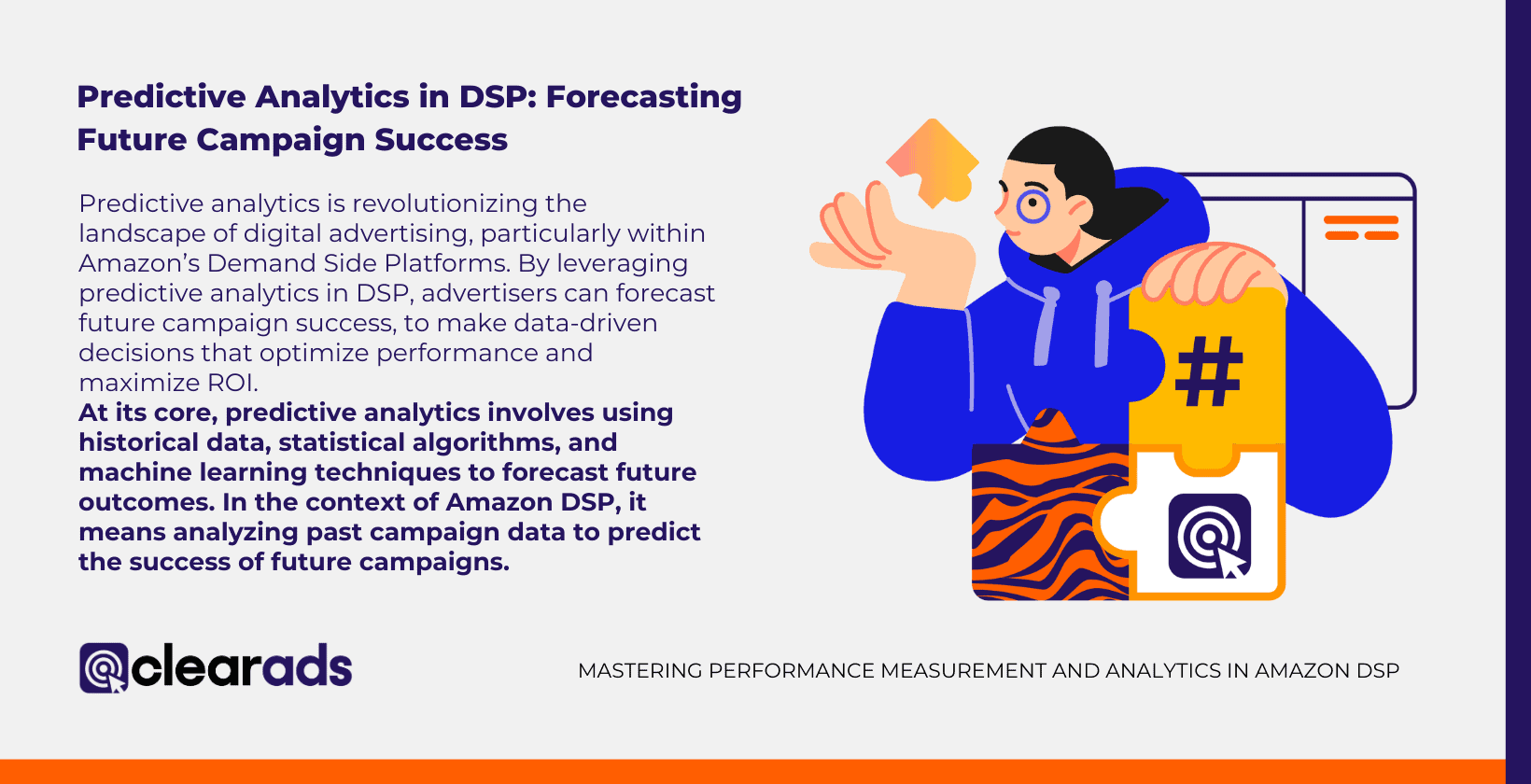
Predictive analytics is revolutionizing the landscape of digital advertising, particularly within Amazon’s Demand Side Platforms. By leveraging predictive analytics in DSP, advertisers can forecast future campaign success, to make data-driven decisions that optimize performance and maximize ROI.
At its core, predictive analytics involves using historical data, statistical algorithms, and machine learning techniques to forecast future outcomes. In the context of Amazon DSP, it means analyzing past campaign data to predict the success of future campaigns. By examining patterns and trends from past campaigns, DSP algorithms can predict how different strategies might perform. This insight is invaluable in planning and optimizing future campaigns.
One of the key advantages of predictive analytics in DSP is its ability to identify potential customer segments that are more likely to engage with specific ads.
How to leverage predictive analytics:
Step 1.
The first step in leveraging predictive analytics is to identify the KPIs that matter most to your campaign goals. Whether it’s click-through rates, conversion rates, or customer lifetime value, these KPIs will guide your predictive modeling.
Step 2.
Accumulate extensive historical data from your past DSP campaigns. The more data you have, the more accurate your predictions will be. This data should include a variety of metrics, from user interactions to conversion data. Employ sophisticated machine learning algorithms to analyze this data. These algorithms can uncover complex patterns and relationships that human analysis might miss.
Step 3.
Before fully implementing predictive insights, test these models in smaller campaign trials. This approach helps in fine-tuning the models and understanding their practical implications.
Four Benefits of Predictive Analytics in DSP
- Proactive Campaign Management: Predictive analytics enables advertisers to anticipate trends and user behaviors, allowing for proactive rather than reactive campaign management.
- Optimizing Ad Spend: By forecasting campaign performance, advertisers can allocate budgets more effectively, focusing resources on strategies predicted to yield the highest ROI.
- Improving Customer Experiences: Predictive analytics can enhance the customer experience by ensuring that users see ads that are more relevant to their interests and needs.
- Competitive Advantage: In a highly competitive digital market, the ability to predict and act on future trends and behaviors can provide a significant edge.
Three Challenges and Considerations
- Data Privacy and Ethics: As with any data-driven approach, it’s vital to navigate the complex landscape of data privacy regulations and ethical considerations.
- Continuous Learning and Adaptation: Predictive models are not set in stone; they require continuous refinement and adaptation to remain accurate and effective.
- Integrating Human Insight: While predictive analytics provides powerful insights, it’s important to complement this with human expertise and intuition.
In conclusion, predictive analytics in DSP offers a transformative approach to digital advertising. By forecasting future campaign performance, it empowers advertisers to make smarter decisions, tailor their strategies more precisely, and ultimately, drive more successful outcomes. As this technology continues to evolve, its role in shaping the future of DSP campaigns will only grow more significant.
The Future of Analytics in Amazon DSP: Emerging Trends and Technologies
Amazon DSP is heading towards more advanced, integrated, and user-focused technologies. These advancements will not only enhance the effectiveness of advertising campaigns but also offer a more personalized and engaging experience to users, all while maintaining a strong focus on privacy and compliance. As these trends evolve, they will undoubtedly open new possibilities and opportunities for advertisers on Amazon DSP.
Key trends and technologies that are expected to define the future of analytics in Amazon DSP:
Artificial Intelligence and Machine Learning
Predictive Analytics: The integration of AI and machine learning is transforming predictive analytics in DSP. These technologies enable more accurate predictions of campaign outcomes, allowing advertisers to optimize strategies proactively.
Automated Optimization: AI algorithms can automatically adjust bidding strategies, ad placements, and targeting in real-time based on performance data, enhancing campaign efficiency and ROI.
Advanced Data Integration
Unified Data Platforms: As advertisers use multiple tools and platforms, integrating these data sources becomes crucial. Advanced data integration technologies are expected to provide a more holistic view of the customer journey across all touchpoints.
Cross-Channel Analytics: With the blurring of lines between different advertising platforms, analytics tools that can provide cross-channel insights will become essential. This will help advertisers understand how their Amazon DSP campaigns influence and are influenced by other marketing channels.
Enhanced Real-Time Analytics
Faster Decision Making: The ability to analyze data in real-time will allow advertisers to make quicker, more informed decisions. This includes instant adjustments to campaigns to optimize performance continuously.
Real-Time Consumer Insights: Technologies that offer real-time insights into consumer behavior will enable advertisers to tailor their messaging and creative strategies dynamically.
Personalization at Scale
Hyper-Personalized Advertising: Leveraging data analytics for creating hyper-personalized ad experiences will become more prevalent. This involves using detailed consumer data to deliver highly relevant ads to individual users.
Dynamic Creative Optimization (DCO): Enhanced DCO tools will enable the automatic customization of ad creatives based on real-time data, ensuring that the most effective creative is shown to each user.
Privacy-Centric Analytics
Data Privacy and Compliance: With increasing emphasis on user privacy, analytics tools will need to evolve to provide deep insights while complying with privacy regulations like GDPR and CCPA.
Privacy-Preserving Techniques: The development of new technologies that can analyze consumer data without compromising privacy will be a key area of focus.
Augmented Reality and Interactive Ads
AR-Driven Analytics: As augmented reality (AR) becomes more integrated into advertising, analytics tools will start tracking and measuring engagement with AR features.
Interactive Ad Performance: Tools to measure the effectiveness of interactive ad elements, like polls or quizzes, will become more sophisticated.
Predictive Customer Lifetime Value (CLV) Modeling
Long-Term Value Prediction: Emerging technologies will enable more accurate predictions of customer lifetime value based on DSP campaign interactions, helping advertisers focus on acquiring high-value customers.
Cloud-Based Analytics Solutions
Scalability and Flexibility: Cloud-based analytics solutions will offer greater scalability and flexibility, enabling advertisers to handle large datasets more efficiently and adapt to changing market needs.
User Experience Analytics
Behavioral Insights: Advanced analytics will provide deeper insights into user behavior and experience, allowing for the optimization of ad creatives and landing pages for better engagement and conversion.
